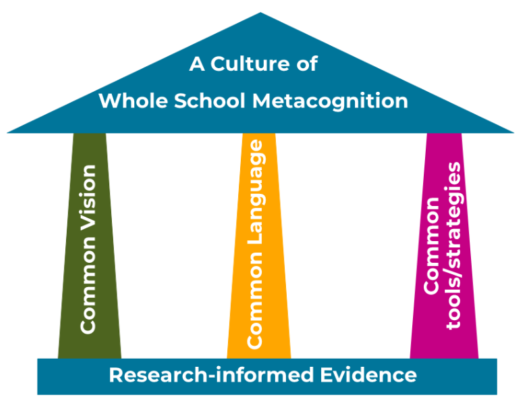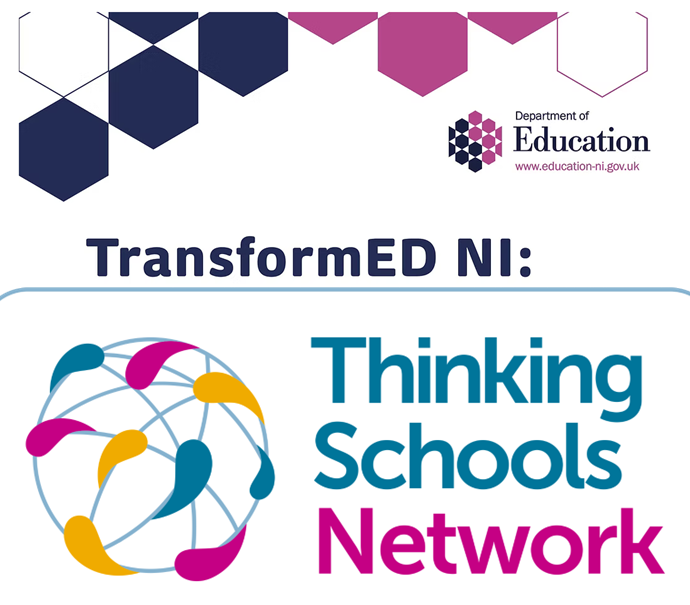What are the benefits of a common metacognitive language?
If I shout duck, how would you respond? Any sense of urgency or fear in my voice would probably prompt a reflexive response. Duck and you would duck! Call and response is one way we help develop and create neural networks to build automaticity and reduce the bottleneck in our working memory.
Additionally, every school wants to grow good thinkers. By identifying the steps that students need to master and explicitly coaching we are able to move towards student-led mindful learning. This is where we seek tools and language to realise our thinking school vision in small steps and stages. Embedding metacognition is not about one approach, it is about a careful approach that engages the whole school community by identifying language and tools common across the school.
Thinking Matters’ temple expresses the importance of three pillars which support every school’s journey to realise a culture of whole school metacognition. To be truly embedded, we cannot just see excellent examples of reflection or top-notch questioning.
A Thinking School engages a vision for whole school cultural change over time. Change, as we know, needs to be thought through carefully in order to be sustained. Thinking Schools are not just about improving questioning, or focusing on certain skills, or implementing a single strategy.
(What will affect your transformative design? DaTS guidance.)

Having a common metacognitive language is important because it allows individuals to communicate and collaborate effectively in their learning and problem-solving processes. When individuals share a common language for discussing metacognition, they are better able to:
- Communicate effectively: A common metacognitive language provides a shared vocabulary and understanding of metacognitive processes, making it easier for individuals to communicate their thoughts and ideas with others.
- Collaborate: When individuals understand each other’s metacognitive processes, they can work together more effectively, providing support and feedback to each other.
- Reflect on their own thinking: A common metacognitive language provides individuals with a framework for reflecting on their own thinking processes and strategies, which can help them improve their learning and problem-solving abilities.
- Develop metacognitive awareness: Using a common metacognitive language helps individuals become more aware of their own thinking processes and the strategies they use to solve problems or learn new information.
Enter Thinking Moves! Roger Sutcliffe drafted the original idea for his metacognitive alphabet whilst sitting at an event about metacognition and considering a practical tool that draws students attention to the thinking they are already using. By provoking ‘out loud’ thinking and making it explicit, students can soon become master thinkers. In his own words, his A-Z is ‘stunningly simple and remarkably rich’. By providing a common vocabulary for thinking we are equipping students with a tool to talk about how they think and learn.
Each Thinking Moves has a symbol and hand signal. The Metacognitive Cycle using four different moves could be expressed as:
- AHEAD = plan goals and think ahead
- QUESTION or ORDER = as you monitor how it is going you need to ask a lot of questions and perhaps order the responses or your steps to reach the goal.
- BACK = reflect on what you have undertaken and review what went well.
Linking Moves into Grooves allows learners to build a series of steps and subsequent actions that over time will show them ‘the right tool for the job’ and help them become master thinkers, more effective learners and problem solvers. Surely, that is always our goal?
By adopting Thinking Moves or a common metacognitive language, we trigger specific cognitive processes or actions. As their neural pathways are reinforced, students will default to the specific cognitive process when processing information or solving problems. The moves become the mental actions or strategies that we use to engage with information and ideas. By understanding and using these thinking moves, our students can develop a deeper understanding of complex ideas and information. In conclusion, a common metacognitive language can help individuals become more effective learners and problem-solvers by improving their communication, collaboration, and metacognitive awareness.
Find out more about our core approach which introduces schools to Thinking Frames and Thinking Moves together or book a one-off training session to introduce your staff and ultimately your students to Thinking Moves



